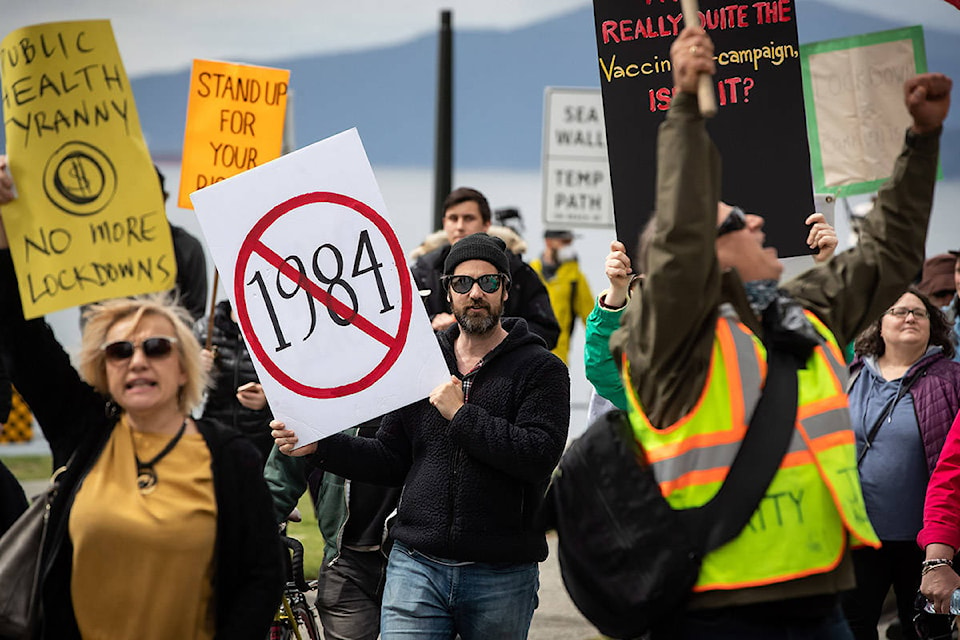The photos were circulating on social media all week.
A man in Pittsburgh dressed in a George Washington mask holding what appeared to be a semi-automatic weapon. A woman in Denver leering out her car window as a front-line health care worker tried to block her path.
Protests against stay-at-home orders that can halt the spread of the COVID-19 pandemic are popping up nearly daily in the United States, with some spilling into Canada, too.
A demonstration in Toronto on Saturday led Ontario Premier Doug Ford to call the participants “a bunch of yahoos.” A similar protest against coronavirus restrictions happened in Vancouver days earlier.
READ MORE: Wage subsidy program opens for applications as businesses struggle amid pandemic
While the majority of Americans and Canadians seem to be adhering to lockdown measures, experts in sociology, political science and history aren’t surprised to see a recent rise in protests.
Alison Meek, an associate professor of American history at Western University in London, Ont., says the U.S. in particular — a country “born out of rebellion” — has historically taken issue with allowing the federal government too much power.
“I see in this very much that individualistic spirit of Americans and that goes right back to the founding of the country,” Meek said. ”They’re not going to listen to the federal government. They don’t believe in that authority.”
While the U.S. has been no stranger to public protests in the past, Meek said there’s more to these pandemic-related demonstrations, including economic factors and ”a real anti-science, anti-expert component.”
“Every expert is saying you need to do the social distancing, you’ve got to flatten the curve. And there is a real sense from a lot of Americans of: ‘you can’t tell us what to do,’” she said. “They’re going to just listen to their own instincts. They’re going to listen to what they see on Facebook or Twitter or whatever social media they’re following.
“So I think it’s just this confluence of stuff that’s coming into play. … and the misinformation that’s out there is making this so much worse than it should be.”
Multiple protests broke out across the U.S. last week, including in Vermont, Virginia, Wisconsin and California, with most of them organized via social media.
A private Facebook group was key in enlisting people for a “Liberate Minnesota” march outside the governor’s home last Friday, and U.S. President Donald Trump backed the protesters on Twitter, calling to “LIBERATE MINNESOTA” right before it happened.
“Trump is that ultimate populist,” Meek said. “When his own experts are saying X, and he comes in and says, ’no, no, no we’re going to do Y,’ that shows even he doesn’t trust his own experts.
“He is this quintessential I’m going to trust my feelings type of guy. … And that trickles down to his supporters, like: ‘why should we trust the PhDs in virology and microbiology?’”
The protests around the U.S. and Canada have been relatively small — roughly 100 people participated in the Toronto demonstration over the weekend and a police spokeswoman said the crowd adhered to physical distancing rules after it was requested.
Still, Max Cameron, a political science professor at the University of British Columbia in Vancouver, said he’s been “appalled” by some of the images he’s seen of the protests, specifically in the U.S.
“But I don’t think I can tell you I’m surprised,” he added. “When the President is sending out tweets, encouraging people to liberate their states and tapping into that states-rights rhetoric, that gives political cover to what they’re doing.”
Cameron sees a disjointed message between policy makers and politicians in the U.S., where different cities or counties within states may have their own rules for physical distancing and business closures.
And that could be sparking some of these protests.
“What we know from studies in public opinion is the public is more likely to be divided if elected officials are divided,” Cameron said. ”But if the political class is relatively unified, society will tend to unify behind what the messages are from our elected officials.”
READ MORE: B.C. will ‘have to find a way’ for families to visit seniors in longterm care: advocate
Zohreh BayatRizi, an associate professor of sociology at the University of Alberta in Edmonton, believes the downturn of the economy is likely playing another major role in the protests.
She said the rollout for government assistance hasn’t gone that smoothly in some parts of the U.S., leading to a conflict between what people are being told to do and their ability to stay economically viable.
But BayatRizi, who’s an expert in the sociology of mortality, sees another layer to the demonstrations.
“It can be hard for people, especially younger people, to think that something fatal won’t impact them, so there’s a sense of being immune or invulnerable,” BayatRizi said, adding that early descriptions of the virus as one that affected mostly older people didn’t help sway that point of view.
“When you’re talking about all those people (protesting) out there, the pictures I am seeing are of younger people or middle aged people, not ones who are much older.”
Cameron said that while images of protests have been hard to see for people adhering to physical distancing themselves, it’s important to remember that these demonstrations are depicting a minority.
He said the bigger picture is the “unprecedented collective action” being done to limit the pandemic’s spread.
“You’d have to go back to war time to find a time when so many people have been asked to sacrifice so much for the greater good,” he said. ”We’re not being asked to go off to war fortunately, we’re just being asked to stay home.
“And the idea that millions and millions of people are doing the same thing in an effort to achieve the common good is a testament to the capacity of good democracies to really get things done.”
Melissa Couto, The Canadian Press
Like us on Facebook and follow us on Twitter.
